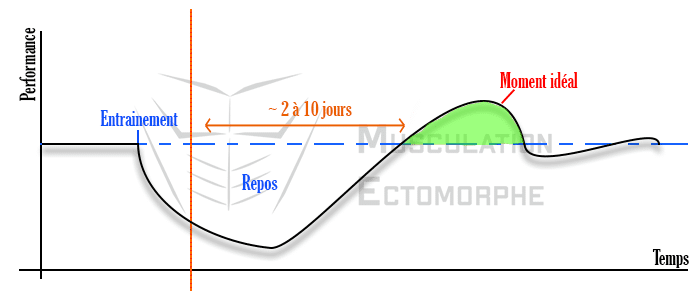Should we do weight training every day? This is the question that many beginners ask themselves to know if the progression will be faster or if it is of no interest.
To give you a clear answer: no, but it can be useful. So, to remove all your doubts, I dug into the subject. You’ll be able to find out if you really need weight training 7 days a week (at least if you will benefit from it).
Let’s see if this is useful for you first, then discussing the advantages and disadvantages of high training frequency. Finally, I’ll give you some tips to recover faster , along with an example of an optimized workout routine , in case you want to work out. bodybuilding every day .

Here is the summary:
Why do you want to workout every day?
Indeed, this is the first question to ask. Why do you finally want to train so much?
There are two main scenarios. So I will give you a concrete answer, whether or not this training frequency will be interesting for you. The answers are of course my point of view, coming from my experience and from my reading. It is therefore also up to you to judge, at the end of this article, what you want to do.
Are you a beginner and want quick results?
If the answer is yes, you don’t need to want to train every day.
Usually, when you start, you tell yourself that the more you train, the faster you will progress. However, it can have the opposite effect, that is, lead to stagnation see regression. As a reminder, the 3 pillars for progress in bodybuilding are:
- Training : damages muscle fibers.
- Nutrition : gives the materials necessary for reconstruction.
- Recovery : Repair damage from training and rebuild through nutrition.
This is the real winning tripod for continuous progress and as quickly as possible. Therefore, wanting to train every day is to neglect part of the recovery in order to prioritize training. In fact, with little experience it is very likely that with so much training you will end up in overtraining , in addition to a big loss of motivation to go to sports.

Note also that everything depends on the volume (how many sets and exercises in a session) and on the intensity . Only the most advanced practitioners have enough perspective to organize their sessions so as not to cross the red zone.
Chances are you won’t, but don’t worry, your progress won’t be slower . As proof, I progressed faster with a half body (over 4 days) than with a Split (over 6 days), because my recovery (especially nervous) was at the top.
You lack time during the day and you want to spread your exercises over the week?
In this case, yes doing weight training every day is a solution.
It is not the most effective way to progress but it is the only way to train to develop your whole physique harmoniously. Therefore, if you have 30 to 45 minutes a day, no question of doing a full body, a half body or a PPL, I advise you to focus on one muscle group per day (Split).
Indeed, you are restricted by the volume of training and you will all have to bet on the intensity of the session . Where you have to be careful is the architecture of your program, it must be thought out in such a way as to optimize your recovery , especially joints and tendons. For example, if you work on the pectorals, avoid doing deltoids the next day since they were used the day before.
3 benefits of weight training every day
The more motivated of you will still be tempted to train without a day off, but before structuring your program, it is important to weigh the pros and cons. To make up your own mind, here are the three big advantages of working out over seven days :
- Duration of sessions: As I could say previously, it is clear that due to lack of time, it will be much easier to structure your program . Thus, the sessions can last an hour, while maintaining a correct volume of work and sufficient intensity.
- Focus on weak points: Often neglected, this is the opportunity to dedicate several sessions during the week, only to a weak point and to train a few strong points on another and the same session.
- Energy management: Exercises are spread out over the week, so it’s easier to maintain a constant intensity during your workout.
3 disadvantages of high frequency training
However, the disadvantages are much more important, to be taken into account, than the advantages for a beginner. Indeed, training according to your weak points and managing your energy requires a little experience. So, in my opinion, here are the three biggest disadvantages of working out every day:
- Recovery Management: Whether muscular, hormonal, nerve and joint / tendon, you need to optimize your recovery from all these angles. For this, it is important to have a personalized weight training program as well as a solid diet plan. Of course, to evolve over time, to avoid stagnation, over-training and injury.
- Motivation hard to preserve: Closely linked to nerve recovery, it is difficult to maintain constant motivation. Also, not giving yourself a day off forces you to go to weight training, whatever you feel like. Better three days a week for a year than every day and quit after a month.
- Flexibility in strength training: There are bound to be days when you can’t work out. Therefore, it shifts all your workouts .
How to optimize your recovery to train every day
Fortunately you can act on the most important lever: recovery. Of course, there is a lot to say and do to improve your recovery. My goal is to give you quick and easy means, to implement, to recover at best between your sessions .

Obviously, recovery begins with rest, especially sleep. Everyone knows the rule:
You have to sleep 8 hours!
Unfortunately, that may not be enough if you want to do weight training every day . So let’s talk about things to optimize in your workouts and your diet.
Joint and tendon recovery
Without good joint and tendon health, you will quickly be limited by the choice of movements. Strength training is above all a matter of time , therefore your joints and tendons must come to the fore.
In general, practitioners don’t give a damn, even worse when ego comes along with the practice. We think it will never happen, but when it does, it’s too late, and sometimes it’s irreversible. There is nothing worse for a practitioner to have medical conditions or an injury that limits their training. For example, tearing a tendon on a biceps (not very aesthetic) or having tired shoulder joints (very disabling for upper body movements) are common injuries.
They can be classified into two categories, pathologies / injuries:
Knowing that the subject deals with doing weight training every day, let’s talk about what interests us, wear pathologies .
The pathologies of wear appear gradually, due to repeated movements . Tendons rub, joints wear out without feeling a particular signal. In theory, the body is able to repair micro-lesions and other damage during rest . For an athlete, the damage is much larger and more frequent, therefore the body sometimes does not have time to fully repair the damage caused during the session.

Act on training to limit damage
First, you can influence the structure of your sessions, giving more time to the repair process.
To do this, avoid moving the same joints during exercises for two days in a row . For example, if you do the pectorals the day before, it is better not to do the deltoids the next day, but rather the thighs or the biceps for example.
Let’s see an optimized training routine:
- day 1: Pectorals.
- Day 2: Thighs (Quadriceps focus) / calves.
- Day 3: Triceps / abdominals.
- Day 4: Back.
- Day 5: Thighs (hamstring focus) / calves.
- Day 6: Deltoids / abdominals.
- Day 7: Biceps / Forearms.
Accelerate joint and tendon recovery
Second, we can speed up recovery through diet . To put it simply, here is a list of food supplements (or foods) that are beneficial to joint and tendon recovery :
- Glucosamine.
- Collagen.
- Wisteria.
- Chondroitin.
- Beef / poultry broths, gelatin and animal fat.
Muscle recovery
Let’s now tackle muscle recovery , which is largely responsible for your progress, especially on your muscle gain . And no, it’s not just a question of waiting for the muscle soreness to end, sore muscles are often misunderstood and deserve to be covered in another article.
A big part of the process is to restore muscle fibers damaged during the session. Fortunately, you can also optimize your recovery through training and nutrition.
Alternate the muscles used
First of all, avoid exercising the same muscle group for two days in a row. In fact, since the workouts are essentially composed of polyarticular exercises, it will not be possible to target only one muscle per day. We must therefore take a closer look at the muscles that work most of the time in synergy , especially on exercises dedicated to large muscle groups:
- Pectorals: deltoids and triceps.
- Back : Deltoids and biceps.
As for the thighs , it may be interesting to focus on the quadriceps one day and the hamstring another day.
The workout routine I described above follows this rule.
2 food supplements for muscle recovery
To get straight to the point, if you stick to the basics of sports nutrition, that’s enough. Here are still two food supplements interesting for muscle recovery:
- Creatine.
- Gainer (protein + carbohydrate). By the way, if you want to make your own drink, I have prepared some recipes to make your own gainer but on.
Nerve recovery
The nervous system will be strained if you exercise every day. Fortunately, there are a few signs that poor nerve recovery :
- Loss of strength
- No motivation
- Stagnation see charge regression
- Constant fatigue
Therefore, it is interesting that you act upstream before you get there.

How to maintain an efficient nervous system
Regarding training, the exercises performed for large muscle groups (pectorals, back and thighs) will be taxing on the nervous system, so it is worthwhile to alternate sessions with heavy and light loads .
When it comes to diet, foods high in magnesium will only be beneficial in keeping your nervous system in good shape. Indeed, it is an essential mineral that contributes, in part, to the transmission of nerve impulses (to contract the muscle ). On top of that, according to the French SU.VI.MAX study, about 75% of people are below the recommended nutritional intake, a phenomenon accentuated by sweating during exertion.
To avoid being deficient, you can find it in certain foods:
- Dark chocolate.
- Oilseeds (almonds, walnuts …).
- Whole grains.
- Bananas…
Likewise, you can use food supplements to cover your magnesium needs. Be careful not to buy it in just any form. It is better to buy magnesium citrate , with few or no additives than magnesium oxide (very common on the market). Of course, the price will be higher, but quality at a price.
Regarding rest , some food supplements exist to improve the quality and quantity of sleep:
- Valerian: calms, soothes and improves the quality of sleep.
- Theanine: (present in tea) helps to relax and reduces stress.
- Tryptophan: (found in plants) Improves the quality of sleep and helps fight depressive disorders.
- Melatonin: Called the sleep hormone and naturally secreted by our body, it can be used to reframe our “internal clock” (often used to deal with JetLag problems).
Hormonal recovery
The drop in testosterone levels is the obsession of the bodybuilding practitioner. Unfortunately, after a workout, this level drops as cortisol rises, the opposite of what we are looking for.
If you want to train every day , your goal is to limit these imbalances through a healthy lifestyle. Therefore, you have to forget about low-calorie diets to dry out, the food must be more than sufficient and rich in good fats. Likewise, stress should be limited so as not to accentuate hormonal disturbances.
Bodybuilding program – every day
Finally, I have prepared an example of a daily weight training program for you. This program meets all the conditions that I have stated above and is suitable for a high training frequency . You can use them to create your own routine.
The selected exercises require little equipment and can be performed in most gyms. Of course, you are free to perform the dumbbells or bar movements according to your preferences.
Despite everything, it is likely that you are not available 365 days a week. Therefore, if you are absent for a day, The next session must be the one that was missed, do not say to yourself:
Chest Monday, thigh Tuesday….
because the volume of work between different muscle groups will be out of balance. Rather, you must reason in daylight. Enjoy
Day 1 – Chest
| Exercise | Series * repeats |
|---|---|
| Expanded declined | 5 * 8/12 |
| Bench press | 5 * 12/15 |
| Cross over at the high pulley (one-sided) | 4 * 15/20 |
| Peck Deck | 4 * 15/20 |
Day 2 – Thighs (quadriceps focus) + Calves
| Exercise | Series * repeats |
|---|---|
| Hack squat | 5 * 8/12 |
| Bulgarian squat | 5 * 15/20 |
| Leg extension | 4 * 15/20 |
| Weighted camel calves | 5 * 15/25 |
Day 3 – Triceps + Abs
| Exercise | Series * repeats |
|---|---|
| Dips | 4 * 8/12 |
| Skullcrushers | 3 * 10/15 |
| Pulley pushdowns | 3 * 10 * 15 |
| Leg raises | 5 * 20/25 |
Day 4 – Dos
| Exercise | Series * repeats |
|---|---|
| Shrugs | 3 * 10/15 |
| Rowing dumbbell | 5 * 8/12 |
| Pullover at the high pulley | 4 * 10/15 |
| Chest pull (or pronation pull) | 5 * 8/12 |
| High pulley overhand pull (one-sided) | 3 * 10/15 |
Day 5 – Thighs (hamstring focus) + Calves
| Exercise | Series * repeats |
|---|---|
| Leg deadlift semi-stretched | 5 * 8/15 |
| Leg press | 5 * 10/15 |
| Leg curl | 4 * 10/15 |
| Seated calves | 5 * 15/25 |
Day 6 – Deltoids + Abs
| Exercise | Series * repetitions |
|---|---|
| Military developed | 4 * 8/12 |
| Side elevations | 3 * 10/15 |
| Bird with high pulley | 3 * 10/15 |
| Crunch | 4 * 20/25 |
| Side crunches | 3 * 25/35 |
Day 7 – Biceps + Forearms
| Exercise | Series * repeats |
|---|---|
| Supination chest pulling ( or supination traction) | 4 * 8/12 |
| Inclined curl | 3 * 10/15 |
| Hammer curl | 3 * 10/15 |
| Wrist curl SUPERSET Wrist extension | 3 * 15/20 |


About the author